
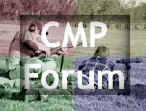
| We want your feedback! Please let us know what you think about TFS. Do you have an interesting story or article that you would like to share? If so, please let us know!
|
Reader Comments:
Regarding the latest update, outstanding work again by the whole CMP crew! New or improved programs, expanded scholarships, new or improved facilities, new rifle and accessory offerings and the super relationships CMP has developed with the ONG and NRA leadership are shining examples of what can be done when one's heart is in the program. You all should be justifiably proud of how the program has progressed into its second century. Somewhere President Teddy Roosevelt has a big grin and is saying a hearty Bully for the CMP! Regards, LTC John F., USAR ret'd
I have truly enjoyed your Shooting Tips site. Even as a 25 yr veteran police sniper/high power shooter,I still find interesting,and useful tips from the successful younger folks coming up through the military,and law enforcement. Keep up the good work!
Det.Tim R.
Wow! Please forward my thanks to everyone responsible for all the improvements I just read about at Camp Perry. Recent years have included quite a few impressive improvements and it looks like there are more this year. The Air Gun range, bath house at RV Park, Bataan Armory remodel, etc are all great. Just letting you know how much we (competitors) appreciate all the work.
Sincerely...
Grayson P.
CMP Shooters' News is one of my favorite email news publications. Information packed, talented authors, timely subjects, and all around well done. What a great service you are providing to the shooting community. Just wanted to say thanks and Merry Christmas.
Newt E.
I enjoy and look forward to TFS and the excellent articles that are published on a regular basis.
Please keep this publication coming and keep the CMP active.
Don M.
One of the members at Snipers Hide pointed out the newsletter and the High Power Tips articles by the USAMU team.
Darn you! I was up until 1:00 AM last night reading all of the articles. Great newsletter and really great USAMU articles.
Thanks,
Michael E.
Great article written on physical conditioning in the latest TFS. I was one of likely many who had asked about the type of conditioning recommended for serious shooters. Sgt. Craig did a great job on describing the routines. Now it’s my turn to put it to work.
Thanks to you, Sgt. Craig and other contributors who share best practices of shooting excellence.
Sincerely,
Keith H.
I use these articles in our high power clinics and have found them very helpful for both new shooters and reinforcement of the basics for the more experienced.
Thanks, Gary M.
Thanks for the great articles on the Carbine, Springfield, Garand matches. All the articles are interesting, but the Carbine, Springfield & Garand are my favorites.
Jim H.
The September-07 on line shooting tips by SSG Tobie Tomlinson, USAMU Service Rifle Team Member, is a great article. I have reproduced 15 copies of it to hand out and discuss to our “newbie” first year air rifle shooters on our high school JROTC Air Rifle Team. Come to think about it believe I’ll hand out a copy to my advance shooters as well. His explanations are simple to understand but rich in detail. Coupled with the sight pictures this article will go a long way towards helping all our JROTC shooters obtain better sight patterns. Keep up the great work. AND…..keep the articles like this coming.
Malcolm V.
CW2 (R), US Army
|
|
|
 |
CMP Hosts National Youth Leadership Conference
By Steve Cooper, CMP Writer
|
|
CAMP PERRY, OHIO - As a coach looking for ways to motivate and train junior shooters, wouldn't it be ideal to spend a couple of days listening to tips, real life experiences and advice from some of the shooting world's best shooting instructors, coaches and match organizers?
Well, in case you missed it, that's what many of your colleagues experienced during the 2008 National Youth Shooting Sports Leadership Conference at CMP's Bataan Armory conference center on 26-28 September. The conference concluded a week of training courses for junior shooting coaches and club leaders.
The program is part of a two-year cycle of major fall training conferences that are co-hosted by the NRA Education & Coaching Division, USA Shooting and the CMP. USA Shooting hosts the National Coaches College at the Olympic Training Center in Colorado Springs in odd-numbered years, while the CMP hosts the leadership conference in even-numbered years.
|
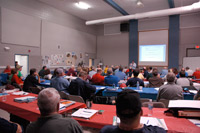
|
|
Over 80 Shooting Sports leaders, coaches and instructors attended the 2008 National Youth Leadership Conference at CMP Headquarters.
|
The two and a half day Leadership Conference culminated a training week that began with four Basic and Advanced Rifle and Pistol Coach Courses. The conference itself focused on developing more knowledgeable and effective junior team and club leaders who can better serve and train junior shooters in their communities. Its fundamental objective is to foster the growth of junior shooting.
Featured key speakers included David Johnson, the National Rifle Coach and 2008 U. S. Olympic Rifle Coach; Ralf Horneber, Sport Director, Bavarian Sport Shooting Federation (Germany); Marcus Raab, NRA National Coach Trainer; Bob Foth, USA Shooting's Director of Coaching Programs and Youth Development; and Rob Harbison, CMP Director of Operations.
In addition, Gary Anderson, the Director of Civilian Marksmanship, provided a pictorial report from the Beijing Olympics with photos taken during his service as an International Shooting Sport Federation Judge during the Olympics. Two of the most successful junior highpower leaders, Bob Hughes of North Carolina and Brad Palmer of Connecticut, discussed how to organize a junior highpower camp.
|
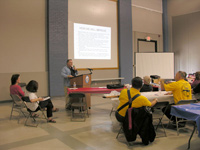
|
|
Tennessee State Junior Director, Ray Harvey, gave a presentation on conducting an intro air rifle demonstration.
|
Ray Harvey, the Tennessee State Junior Director, shared his successful experiences in conducting an introductory youth air rifle demonstration event at Gatlinburg's Winterfest, while Richard Whiting, whom Gary Anderson introduced as “the best highpower rifle Chief Range Officer in the country,” discussed the conduct of competitions and the responsibilities of range officers.
Richard Hawkins, the US Army Marksmanship Unit’s Service Pistol Coach, covered scientific research he is conducting on body position, weight distribution and endurance as it relates to improving shooter stability and scores.
The featured presenters covered several important topics including prepping juniors for Olympic-style shooting, lessons learned at the Beijing Olympics, motivating junior shooters, fundraising, increasing club membership, coach effectiveness and skills, advertising and promotion, growing competitions and an insightful look at shooting in Bavaria, Germany's largest province.
In his two presentations, David Johnson discussed highlights of the Beijing Olympics and how USA Shooting develops its Olympic team from the local club to the Games.
He discussed USA Shooting’s plan to prepare for the 2008 Olympic Games, where they employed incentives for medals won, team-building techniques, participation in training camps and successful goal-setting strategies.
Coach Johnson singled out issues such as crowd noise, something most shooters don't encounter in a home range setting, but which was a real concern in Beijing. “The Chinese are very vocal in support of their teams and it made concentrating on shooting that much more difficult,” he said.
At the Beijing Games, the US brought home six medals in shooting - two gold, two silver and two bronze. In addition to four medals by US trap and skeet shooters, Matt Emmons of Browns Mills, N.J., took home the Silver in Men's 50-Meter Prone Rifle and Jason Turner of Rochester, N.Y., was awarded a Bronze Medal in the Men's 10-Meter Air Pistol. In the women’s rifle events, 10-Meter Air Rifle and 50-Meter Three-Position Rifle, Jamie Beyerle of Lebanon, Pa. just missed two medals, finishing fourth and fifth.
While praising his entire team, Johnson discussed the ups and downs of Beyerle and Emmons over the past two Olympic cycles as an illustration of what it takes to mentally and physically prepare for events that require years of preparation.
|
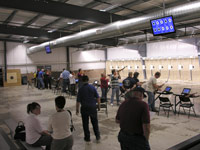
|
|
Conference participants were given an opportunity to shoot a 20-shot "Fun Match" with Air Rifles and Air Pistols during the conference at the CMP's new Competition Training Center.
|
In his second presentation, Johnson discussed the prototypical path taken by shooters from their beginnings at their local range to successfully earning a place on an Olympic team.
He said it's his job to identify potential talent, develop, nurture and train those talented shooting athletes toward international success. In doing so, he described the four-year cycle which begins and ends with the Olympic summer games.
In fact, he has already begun his planning for the 2012 Games in London which involves budgeting, shooter development, team selection, training and eventually shooting in international competition and finally, competing in the London Games.
Once the top juniors smallbore and air rifle shooters are identified, they may try out for the National Development Team, a phase where they will train and compete with the best juniors from across the country in a series of matches. Advancement continues until eventually the top two shooters in each event make the Olympic team.
Johnson, who is a Major in the U. S. Army Reserves, said it always boils down to talented shooters who have the discipline and drive to succeed.
Ralf Horneber, Sport Director of the Bavarian Sport Shooting Federation in Germany, provided conference attendees with two sessions describing the structure of shooting in Germany and the development and training of his country's junior shooters.
He described the history of shooting in Germany as well as its organizational structure that is based on the geography of Germany. He explained how each German Federal State like Bavaria, its largest state, has its own shooting federation with a full-time staff and a full array of shooting programs. He said Germany is about the size of Montana while the state of Bavaria is about the size of West Virginia. There are 480,000 members in 4,800 shooting clubs in Bavaria out of a population of 12 million, and all are participants in target shooting activities of one type or another. The total population of Germany is 82 million, he said.
Horneber said that unlike the U.S., shooting is an important part of the social and cultural fabric of Germany. Shooting, which began with archery and crossbow shooting has grown to encompass today's various forms of marksmanship and has developed as a highly-respected tradition dating back to the middle ages. It is common for families to pass along their shooting heritage from generation to generation, always expecting more from the next, he said. Due to the high population density in Bavaria and the other German states, it's common to have shooting ranges within walking distance of many people's homes.
He explained the structure of German shooting clubs and leagues - the most popular being the Bundesliga or federal shooting league. The Bundesliga is a highly popular 12-year-old league system that provides an opportunity for recreational and high-level shooting competition nationwide. It helps prepare and feed shooters to the German national championship and eventually Germany's Olympic teams.
In Horneber's second presentation, he described the process of developing junior shooters from the club level to regional, Bavarian and national levels. With 15,000 shooting clubs in Germany, a sophisticated and organized system has evolved to develop and channel junior shooters into the national shooting scene, he related.
In Germany, there is a highly-standardized training program to ensure consistency from a shooter's introduction to the sport all the way to Olympic competition. There are between 5,000 and 7,000 shooting coaches in Bavaria and each coach is licensed and categorized into one of three levels from entry-level to expert.
Horneber said promising shooters from around the country are selected for membership on regional squads. Regional training centers funnel the best shooters to state and national training squads through a series of competitions that occur in March, June, July and August of each year. The system produces a final pool of approximately 40 shooters from which the national team selects its members.
For more in-depth information on Maj. Johnson's Beijing Olympics experience and Ralf Horneber's fascinating look at sport shooting in Bavaria, you can find related stories in this edition of First Shot Online.
|
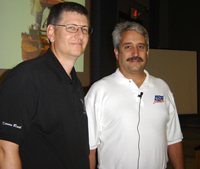
|
|
Both Marcus Raab, NRA National Coach Trainer, and Bob Foth, USA Shooting Director of Youth Programs and Youth Development, gave presentations during the Conference.
|
Marcus Raab, NRA National Coach Trainer discussed the qualities of good coaches and focused on what coaches should know and what they should do to succeed as mentors.
"Coaches have to be a good at communicating, teaching, organizing, planning and must serve as a role model," Raab said. He emphasized the necessity to teach character to young shooters.
He said coaches need to have knowledge of technical issues, rules and procedures, competition strategies, first aid and risk assessment and should possess the skills needed to maximize the performance of competitors.
Raab stressed the importance of being a good communicator throughout the process, not only verbally, but through the use of body language and tone. He said coaches need to be active listeners, provide feedback and know how to resolve conflicts.
Psychology is a large part of coaching, Raab said. Teaching the skills of goal-setting, imagery, relaxation, energy management and self talk are all critical components of developing youth shooters. Physical conditioning, training and safety issues are hallmarks of a good coaching platform, he said.
Bob Foth, USA Shooting Director of Youth Programs and Youth Development dovetailed his remarks with Raab while focusing on effective leadership and the importance of finding capable assistant and being an effective delegator.
He said it is important for coaches to find good assistants who can assume some of the burden of non-coaching duties such as range safety, running competitions, fundraising, media relations, equipment, facility maintenance and training.
While multi-tasking is an important skill, a coach who is focusing attention on a young shooter cannot be a range safety officer at the same time, Foth said.
"It's impossible to have your eyes in both places," he said. "Obviously for safety reasons there must be a division of responsibility."
Rob Harbison, CMP Director of Operations, discussed the volume of training needed to bring along a young shooter. He said one of the most common questions he's gotten over the years is "how much training is required to become a good shooter?"
He then broke down the reasons for shooting and explained how that core question will answer itself. While it's impossible to predict the number of hours or rounds of ammunition that are required, those questions begin to answer themselves as the shooter identifies their goals, he said.
Most shooters shoot for fun, Harbison said. He categorized shooting levels as 1) fun - just plinking and enjoying a day at the range, 2) fun plus - where shooters concentrate and make an effort to post respectable scores, 3) winning at the club level - where shooters take competition seriously and strive to be the best in their club and 4) elite - where club level champions seek to reach the highest levels in their sport.
Harbison recommended that all serious coaches and shooters develop training plans to help them succeed at the competitive level that matches their personal goals. While stressing the importance of time management, he said the elite shooter must have an articulated goal, backed up by quantifiable tasks. He said those tasks will dictate the purposes and structure of daily training.
He concluded his presentation with creative approaches to coaching and illustrating different styles of coaching that can be most effective in training junior shooters.
If you missed this year's conference, watch for an announcement of dates for the 2009 National Coaches College by USA Shooting. Those dates will be posted on the CMP website as soon as they are available. Dates for the 2010 National Youth Leadership Conference are expected to be set soon and will be posted on the CMP website.
NEXT ARTICLE
|
|
|


